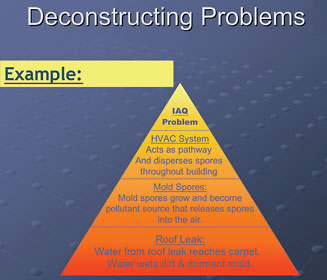
This was the message from Loren Hubbard of Lindhart Technical Services and Tommy Gwaltney of Air Quality Systems Inc., who outlined their views on the subject at the recent NADCA meeting.
Their session, "Indoor Air Quality: Benefiting from the Complete Picture," emphasized the importance of looking at the entire IAQ picture in order to provide quality results.

If a contractor is to control a building's IAQ, "we must control and understand pressurization," he said.
"Excessive positive or negative pressures can move large quantities of moisture-laden air through holes in a building's shell, leading to condensation and mold growth within building cavities."
Because of varying sensitivities to airborne chemicals and irritants, individuals with heightened sensitivities may react to a particular IAQ problem although other occupants do not experience any ill effects. The two speakers also warned that in addition to different degrees of reaction, an indoor air pollutant or problem could trigger different reactions in different people.

Deconstructing Problems
Hubbard noted that there is a fifth P: problems. He agreed that at first glance, many IAQ problems are like an intimidating puzzle. "Once you learn how to deconstruct a problem, however, you are well on your way to providing a solution," Hubbard said.To deconstruct an IAQ problem, he recommended incorporating the four P's into the investigation process, going through one at a time. In regard to people, he recommended that all complaints be treated seriously and professionally.
He recommended hiring outside testing, especially if warranted by an investigation.
Above all, he said to communicate with all parties involved and keep accurate records of responses at meetings.
In the deconstruction process, Hubbard agreed that preventing extreme building pressure "is much easier said than done."
In most structures, he said, the indoor-outdoor pressure difference results directly from the combined effect of weather, wind, and operation of the mechanical ventilation system.
Hubbard then demonstrated how to resolve an IAQ issue by zeroing in on the four P's. Putting it into even simpler terms, he said to examine the air equation. He told the audience that air coming in (both ventilation and infiltration) should be equal to air going out (exhaust and exfiltration).
In summation, Hubbard said the first step to understanding IAQ is to know the four P's. Then, in order to solve an IAQ problem, identify the four P's. This decision-making process, he said, can be applied to any given indoor environment problem.
Sidebar: NADCA Forum Addresses International Issues
LAS VEGAS - The 16th annual National Air Duct Cleaners Association (NADCA) meeting and exposition certainly had an international flavor to it. An international forum occupied the attendees' time for the entire first day. Speakers from all over came to tell members what's going on in their respective parts of the world.European Ventilation Hygiene Association (EVHA) representative Gary Hargreaves, from the United Kingdom, introduced the association to NADCA members. He pointed out the progress of the indoor air quality (IAQ) industry in Europe.
Hargreaves included a summary of individual member state legislation and the need for progress regarding the development of a definite policy regarding duct cleaning throughout the European Union.
Other speakers included Roger Malmstrom of Sweden, Raffaele Caruso from Italy, Tim Lawson of Denmark, Timo Jalonen of Finland, and Kazuhiko Ohmawari of Japan. Among the issues Caruso brought to the forefront included how the association can and should assess, manage, and circulate technical information.
Giorgia Ziragachi, vice president of EVHA, described a typical experience of a national association member working in accordance with NADCA guidelines. Jalonen, on the other hand, not only talked about grease extract system maintenance within Europe, but the current status, recent growth in technological development, system cleanliness, and assessment/verification techniques. He also disclosed some of the European studies and research programs taking place, including an overview of the varied research programs relating to numerous factors associated with IAQ.
Ohmawari discussed air duct cleaning in Japan, where it stands, and surrounding issues. Topics included laws and ordinances relating to air duct cleaning, cleaning and quality standards, marketing, and the current status of the market. He stressed that his country is pushing for more industry education and training.
Publication date: 05/02/2005

Report Abusive Comment